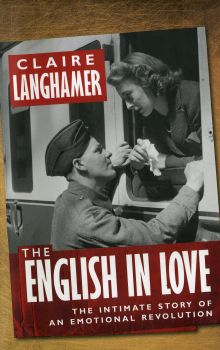Broadcast: News items
How romantic expectations transformed 20th-century marriage
Posted on behalf of: History
Last updated: Friday, 16 August 2013


Dr Claire Langhamer
Love, romance, sexual fulfilment … a new book by a University of Sussex social historian embraces a period of the 20th century that has often been regarded as a golden age of marriage.
But beneath the slushy advertising slogans, romantic movies and an eagerness for wedlock, Dr Claire Langhamer suggests in The English in Love – to be published on Thursday (22 August) by Oxford University Press - that all was not so rosy.
Through examining not just the popular culture and media of the years between 1920 and 1970, but also personal diaries and letters of the people of the time, Dr Langhamer discovers that English society was undergoing an “emotional revolution” that brought about just as much disappointment and unhappiness for couples as it did openness and liberation.
As she observes from the nation’s reaction in 1955 to Princess Margaret ending her relationship with divorcee Captain Peter Townsend: “The royal crisis occurred at a time when the emotional landscapes was changing. Margaret’s battle between love and duty was one manifestation of a wider conflict between self-discipline and self-expression.”
The golden age of marriage began after the First World War when, under the influence of Freudian theories, marriage reformers pushed the idea that that love was the best way to tame sexual desire and that both could be tightly bound within the notion of modern marriage.
“Married love increasingly promised more than mere companionship,” writes Dr Langhamer. “It offered a dynamic emotional connection where personal transformation was a shared project achieved through togetherness.”
But, although more people than ever were tying the knot - by 1970 only eight per cent of women between 45 and 49 had never married – people were also realising (at a time when divorce was difficult to obtain) that expectations in these relationships were hard to meet.
Referring to diaries kept at the University in the Mass Observation Archive, Dr Langhamer discovers that women and men were conflicted by many issues, from marrying or having relationships with people outside their social class, to feeling they were never likely to find a spouse unless they improved their dancing skills.
In her quest to uncover an accurate picture of these decades, she explores the conflict between passion and pragmatism, the trials of courtship (from snogging in cinemas to assignations in air-raid shelters), and the question of ‘living in sin’.
By the end of the century, attitudes towards sex and marriage had changed so much that, as one Mass Observer opined: “… now sex comes much earlier on. Living together, even in the sixties, generally meant you were going to get married. But not now. Even being engaged doesn’t seem to mean you’re going to get married. So there doesn’t seem to be much room for the courting phase does there.”
The English in Love has been reviewed in the Guardian, the Economist and Times Higher Education

